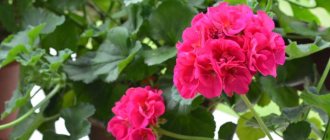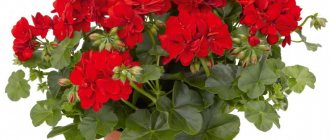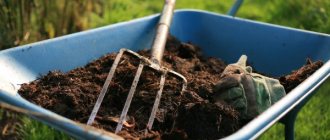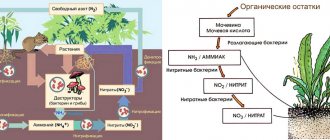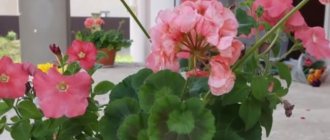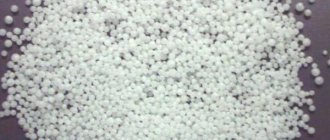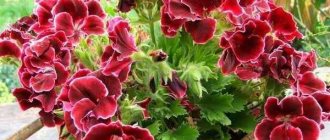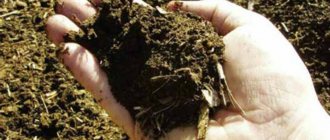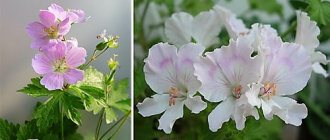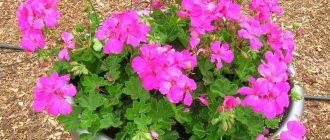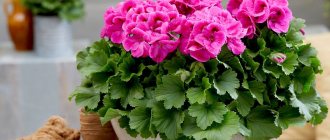Category: For flowers and indoor plants Reading time: 8 min · Views: 6,136
Only certain types of geraniums, or pelargoniums - this is their second name - can cause trouble. These are hanging varieties, that is, they do not grow upward, but in the form of a rigid vine hanging from a flowerpot. And also, probably, royal pelargonium, with its two- and three-color terry buds. To cope with these problems, you have to use fertilizer for geraniums - like any type of plant, this “folk flower”, it turns out, has its own preferences.
How to determine that a plant needs feeding?
For stable development of geraniums, as well as timely flowering, it is necessary to fertilize the soil. Depletion can occur 3 months after planting in the ground. At the same time, the owner of the flower should remember that the plant cannot replenish its nutrition on its own. As a result, it is recommended to supplement with vitamins and mineral fertilizers.
Geranium is fading
Based on frequency, bait is classified into:
- constant, which is applied according to a set schedule, according to the periods of plant development;
- urgent is added as a result of the manifestation of negative factors.
Clear indicators of fertilizer shortage include:
- yellowing and falling leaves;
- growth slowdown in spring and summer;
- lack of flowering during periods of activity.
What kind of soil does a flower need?
Soil for geraniums
Geranium can be classified as a type of plant that takes root in almost any soil. However, you shouldn’t rush and buy just anything. The required soil must contain:
- universal mixture;
- vermiculite;
- fine sand;
- peat soil:
- humus.
Important! For stable flower growth, it is necessary to use loose soil with drainage at the bottom of the pot.
Feeding at different times
The frequency of fertilization depends on the time of year. In autumn and winter, the feeding of geraniums is reduced or completely stopped.
With the onset of warm weather in the spring, feeding with nutrients is resumed no more than 2 times a week. During flowering, the additive intensifies. However, do not get carried away; increasing the amount of fertilizer will disrupt the growth and development of the plant.
in spring
After trimming dry shoots, it is necessary to add substances with nitrogen. Once every 2 weeks, geraniums should be fed with complex mineral and organic fertilizers.
Traditional methods using improvised means, for example water with iodine, are also suitable. This set will allow the flower to restore its strength after a period of dormancy.
Feeding geraniums in spring
In summer
During the summer, the plant grows and blooms; experts recommend feeding it at least once every 12 days .
in autumn
Fertilizer in the autumn period is reduced to a minimum, as a result of the fact that the geranium goes into dormancy mode. The frequency of feeding depends on the type of flower, no more than once every 1.5 months .
in winter
In the cold season, the flower goes into complete dormancy. At the same time, growth and development stops. Flowering stops completely. Gardeners stop continuous feeding, but when storing in a warm place, it is necessary to add half the usual dose of minerals. In this regard, it is recommended to keep geranium in a cool place.
Why doesn't the plant bloom?
Lack of inflorescences on geraniums
If the flowering of a plant stops during the period of activity, it is necessary to understand the reasons for this phenomenon and try to eliminate them in a timely manner. Common factors affecting the normal growth of geraniums include:
- Lack of substances necessary for growth in fertilizers. Geranium has a positive attitude towards bait containing potassium.
- Care must be taken when moistening the soil. The plant can be damaged by frequent watering; experienced gardeners recommend adding water no more than 2 times a week.
- When planting a flower, a new container is selected according to its size. When placed in a large pot, the geranium will begin to stretch vigorously, and the flowering process will stop. If the necessary container is not available, then it is necessary to plant a couple of bushes in one, but the increased upward growth will stop. Forces are redistributed to flowering.
- Circumcision surgery should be performed in spring and autumn. Active foliage growth will prevent the plant from reproducing through flowering. To prevent this phenomenon, gardeners cut off the lower and upper side shoots of geraniums.
- Positioning in a dark place causes the stem to stretch. Pelargonium should be kept on windowsills, but avoid direct exposure to sunlight.
- Placing the plant in a warm place during the dormant period leads to detrimental consequences. It is recommended to store at a temperature no higher than 16°C, and also reduce the humidity level.
- Unsuitable soil composition leads to poor flowering. For pelargonium, it is recommended to use garden soil, fine sand and mullein humus.
- The occurrence of diseases. A visual inspection during watering will help prevent the death of geraniums from disease and pests.
Important! The plant must be replanted at least once a year, and the old soil must also be constantly updated.
How to feed geraniums for good growth
Adult geraniums usually grow well, which cannot be said about young plants. They need a boost to grow well. At first, rooted cuttings grow in cups without feeding. As soon as the roots begin to appear through the walls of the glass, the cuttings are transplanted into pots with a diameter of 8 cm, given 2 weeks to adapt and begin to be fed with Planta Miracle Growth fertilizer once every 5 days.
After another 2-3 weeks, a new transplant is carried out into pots with a diameter of 10 cm. When the plants take root, Kemira is used for active growth, alternating the drug with potassium nitrate to prepare for flowering. Apply fertilizer every 7 days. Instead of Kemira, you can use Fertika; the composition of these fertilizers is identical.
What is necessary for good flowering and growth of geraniums: video
Feeding during flowering
Feeding geraniums
To normalize plant growth, flower growers are advised to follow the following tips:
- liquid fertilizer is poured after watering;
- the fertilized soil is loosened;
- It is forbidden to feed geraniums for 2 weeks before moving to another container, as well as a week after;
- Flowers infected with pests and diseases are not fed.
Features of feeding geraniums
- When feeding, it is important to follow the dosage. If you add too many nutrients, the leaves will turn yellow and wilt.
- Nitrogen fertilizers for geraniums help it recover. They are added after pruning.
- Feeding geraniums for abundant flowering does not require special expenses. The main thing is to water the geranium with iodine dissolved in water, add a complex of minerals, observing the dosage.
You may be interested in: Fertilizer for cyclamen
Popular Home Remedies
When caring for geraniums at home, any folk remedy can come to the aid of gardeners. Let's consider what baits can be used and with what dosage.
Camphor
This remedy is not a panacea, but it will help restore normal growth of geraniums. This growth stimulator must be added in the amount of one teaspoon per liter of water. Afterwards, close the container and mix the contents by shaking. Watering is carried out at the root, or sprayed on the foliage and young shoots.
Banana peel
Banana peels must be dried in the oven. Then the blanks are crushed in a blender and added to a 1-liter container of water. Additionally, apply a tablespoon of egg shells, as well as magnesium sulfate. Leave for 3 hours, separate from the cake. Spray on the foliage, feeding frequency no more than once every 2 weeks.
Iodine
The pure preparation is harmful to the root system of the plant. The florist needs to prepare an aqueous solution; add 5 mg of iodine concentrate to 1 liter of liquid, then mix the contents. It is recommended to pour the solution into the soil in an amount of 50 ml for one plant.
Iodine and peroxide
Hydrogen peroxide and iodine can be used to enhance the growth and flowering of geraniums. Add a drop of iodine and 2 ml of peroxide to 1 liter of water. Watering is carried out along the outer contour of the root ball, while preventing the prepared solution from getting on the flowers and sprouts of geranium. Up to 60 ml of liquid is poured into 1 pot, no more than once every 3 weeks.
Egg white
Pour the white of a chicken egg into a glass of water, separating it from the yolk. Fill the container to the brim with heated water and leave for a week in a dark place. The concentrate is poured into a container with 2 liters of water and mixed. Watering is carried out no more than once every 2 weeks.
Yeast
Ordinary yeast can be used as a growth stimulator. Up to 120 grams of the substance are poured per liter of water. Watering must be carried out within a few minutes after preparing the solution.
Attention! If an overdose of mineral fertilizers has occurred, it is not recommended to use a yeast solution, as it will provoke harmful reactions.
Dairy products
Up to 150 ml of milk is poured into a liter container of water. After mixing the liquid, you can use it for watering. This solution helps restore the plant's calcium balance for normal growth.
Tea
The used tea leaves are mixed with wood ash, and the ratio is maintained at 1:1. The mixture is poured onto the soil and mixed with it, eliminating the concentrate from the surface. As a result of the fertilization procedure, the flower is saturated with nutrients. Tea can be added to the soil when replanting geraniums.
Aquarium water
Water from pet fish can be used as an activator for active flowering of the plant. It has been experimentally proven that this folk remedy helps restore pelargonium after a period of dormancy.
Onion peel
Onion skin contains useful substances such as carotene, phytoncides and a complex of vitamins. Together, these substances reliably protect the plant from pests and diseases. Pour 1.5 liters of water into an enamel container with water and pour in a handful of dry onion skin. Boil for up to 7 minutes and let the infusion cool. Spray on foliage and roots, as well as directly water geraniums.
Orange peel
The peel of citrus fruits contains a substance called limonene. It can destroy the protective shells of many insect pests, destroying them in colonies. The crushed peels are poured with hot water and allowed to brew for a while. Then water the roots and foliage.
Water with sugar
Geranium is considered a sugar-loving plant. To make syrup, you need to add up to 3 tablespoons of sugar to 1 liter of water and, after stirring, pour over the root system. This replenishes the flower with organic fertilizers.
Features of care and fertilization of pelargonium
Geranium does not require any special care or treatment. This is a strong and unpretentious plant that can survive even under the most unfavorable conditions. And all the bait is needed only to make the bush more lush and more profusely flowering.
Frequency of feeding geraniums
You should not feed pelargonium more than a couple of times a month. From an overabundance of minerals and organic matter, the plant’s leaves may begin to turn yellow. It will begin to choke. In some cases, due to an excess of mineral water, the plant may even need to be replanted.
Remember! In everything you need to observe moderation, therefore, do not stuff the plant excessively with everything! It will wither away!
How to feed geraniums to prevent the leaves from turning yellow?
Yellowing of leaves can occur for a number of reasons and resuscitation of the plant should be carried out based on what caused it. For example:
- Due to yellowing of leaves due to waterlogging (if moisture stagnates for a long time and is not absorbed into the soil), drainage should be checked. It is best to dig up the plant and replace the ineffective drainage with fresh one. Upon completion of the transplant, you can feed it with organic matter (rotted manure) and water it with a weak glucose solution.
- The indoor geranium has grown too much and a small pot is no longer enough for it. The problem is eliminated by transplanting into a larger pot. Transplantation is carried out using the “transfer” method and after replanting into new soil it is better not to fertilize for a while, or to water it with a weak solution of iodine.
- Excess mineral water. In this case, a transplant is necessary. In case of severe burns and damage to the root system, it may be necessary to rinse the root system under running water. After such manipulations, the geranium that does not like replanting will take a very long time to leave, and since the plant has “gotten enough” of mineral water this season, it is better to feed it with organic matter for now, and only when the plant begins to show a tendency to improve.
Blooming geraniums are replanted only in emergency cases!
FAQ
Caring for geraniums
New gardeners may often have the following questions:
- Soil composition . The soil should consist of small stones at the bottom, peat soil, rotted mullein, fine river sand, and it is also possible to use a ready-made mixture from retail outlets.
- Signs of the need for bait. These include: yellowing of foliage, slowing or cessation of growth, lack of flowering during periods of activity.
- What to use for pest control. In this case, an infusion of orange peel and onion peel will help.
As a result of proper care at home, even novice gardeners will be able to preserve the plant, as well as enhance its growth and flowering during the active period.
Geranium care
Geranium is not demanding on living conditions. But for abundant flowering it requires certain conditions.
The plant does not need too fertile soil, otherwise it will actively grow green mass to the detriment of flowering. The substrate should contain garden soil, humus and sand (2:1:1). It is better to put expanded clay or other drainage at the bottom of the pot; geranium does not like stagnant water.
Watering should not be frequent. Rare, fairly abundant watering is preferable - geranium is drought-resistant.
Important! Pelargonium does not like humid air or spraying.
Strawberries at home all year round! These veneers are 100 times better than false teeth! And they cost pennies! Up to 15 kg of strawberries every month! Dental veneers for pennies! Up to 15 kg of strawberries every month! The famous overlay veneers are now in Russia!
The plant prefers well-lit places. Tolerates partial shade normally. However, if you do not expose it to light in time, flowering may be delayed. Direct sunlight, especially on hot summer days, is extremely undesirable. They will cause multiple burns on the leaves, and the plant will have to recover for a long time.
During the flowering period, the optimal temperature is from 19 to 26 degrees Celsius. At night it should drop slightly. You should not place geranium near heating devices - the plant does not tolerate extreme heat. In winter, during the dormant period, the acceptable temperature is considered to be quite cool - from 6 to 11 degrees Celsius.
Note. The plant loves fresh air, but not drafts.
